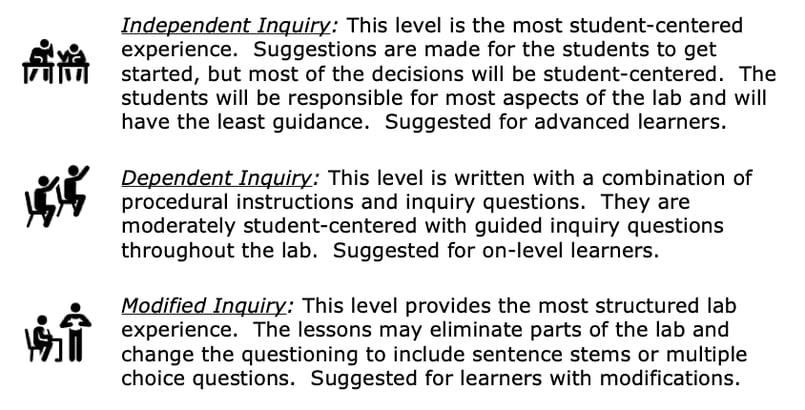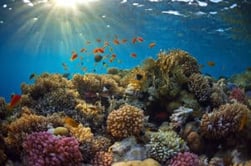Thermal Energy and Conduction, Convection, and Radiation Inquiry Lab
Middle School Inquiry Lab on Thermal Energy and Conduction, Convection, and Radiation
In this lab students will examine thermal energy transfer through stations that illustrate conduction, convection, and radiation.
Each inquiry lab will contain an essential question that will drive the lesson and make students think. For this lesson, the essential question is:
- How is thermal energy transferred?
BACKGROUND INFORMATION AND MATERIALS LIST:
Students will begin the lab by reading the essential question and background information. This can be done individually, as lab groups, or as a whole class. If you consider lab groups, you also might include some type of whole class formative checks before digging into the lab.

Materials List:
- Station 1 Materials:
- 3 metal pie pans
- dark potting soil
- light-colored sand
- room temperature water
- goggles
- 3 thermometers
- reflector lamp, 200-watt bulb
- stopwatch
- 500 mL beaker
- masking tape
- graph paper
- colored pencils
- Station 2 Materials:
- 1 washer tied to a 5″ string
- 30 mL hot water (not boiling)
- 2 8 fluid oz. Styrofoam cups
- goggles
- room temperature water
- 2 thermometers
- hot pad
- Station 3 Materials:
- 2 250 mL beakers
- 2 8 fluid oz. Styrofoam cups
- oven mitt
- hot water (not boiling)
- 2 coffee stirrers
- ice water
- goggles
- yellow and blue food coloring
- forceps
- stopwatch
- permanent marker
PROCEDURE:
For this lab, students will complete three stations in order to determine how thermal energy is transferred. The first station focuses on radiation energy, and students will set up three pie pans with three different materials in each. One pan will have soil, one will have sand, and the final will have water. Students will place a lamp above all three to test how radiation energy heats up the pans. Students will also place a thermometer in each to record the temperature change during a 10-minute time period.
The second station moves towards conduction, where students will heat up water by transferring a hot object from one cup to another. Students will use two cups, one holding room temperature water, and the other holding hot but not boiling water. Students measure the temperature of the two liquids and record the data on their lab sheet. For the transferring of heat, students will submerge a metal washer into the hot water. After the hot water's temperature with the washer in it stabilizes, students will take the washer out and place it into the room temperature water. Students will take a final temperature reading to see if there was an increase in temperature for the cup that had the room temperature water in it originally.
The final station is all about convection, where students will see how cool water sinks while warmer water rises. For this section, students will be using a couple more cups with water. Students will place hot water in a cup that already has cold water, as well as pour cold water in a cup with hot water in it. Using a funnel to combine the waters, students will make observations as to how the waters mix when combined.
CHECK FOR UNDERSTANDING:
At this point in the lab, students will be checked for understanding by answering questions about their findings. Here are a few that come with the lab:
- Which substance absorbed heat the fastest? How can you tell?
- How did the heat transfer from the lamp to the sand, soil, and water? How can you tell?
- What was the effect of putting the hot washer into the room temperature water?
- How was heat transferred in this activity? How can you tell?
- Which form of heat transfer do your observations fit? Why?
CONCLUSION
Students will go back to the essential question and write a CER (Claim, Evidence, Reasoning) to conclude the lab. Once completed, students will reflect back on their learning by answering the following questions:
- A typical oven has a heating element at the bottom that glows red with heat to bake food. What form of heat transfer is this? Why?
- In a lava lamp, a bulb at the bottom of the lamp heats the liquid inside, making bubbles rise to the top. Once there, they cool and fall down to be warmed again. What form of heat transfer is this? Why?
MODIFIED AND INDEPENDENT INQUIRY VERSIONS
All of the Kesler Science inquiry labs come with three different modification levels. Each lab is differentiated using the icons below.
STANDARDS ALIGNMENT
TEKS: 6.9 A – Investigate methods of thermal energy transfer, including conduction, convection, and radiation.

Download Over $100 in FREE Resources
For Middle School Science
Simply create a login below and gain immediate access to a selection of our Kesler Science product line worth $100 - for FREE. There's a full version of every product type! You'll also join tens of thousands of middle school science teachers who receive timely tips and strategies straight to their inbox.





